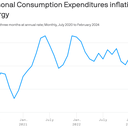Inflation has been stubborn in 2024. Is it a bump in the road, or a warning sign?

Which is more important: that the general trajectory of inflation over the last year remains downward, or that price gains tick up substantially in the first two months of 2024?
Why it matters: Your answer determines whether you view the latest inflation data as a bump in the road to be ignored or as a warning sign that markets and policymakers alike have gotten overly complacent about the risk of inflation getting stuck at an unacceptably elevated level.
Driving the news: The Personal Consumption Expenditures Price Index, the inflation measure targeted by the Fed, rose 0.3% in February as the year-on-year rate ticked up to 2.5% from 2.4%, according to data out Friday.
- The core measure, which excludes volatile food and energy, also logged a 0.3% monthly gain as the year-on-year rate dipped to 2.8% from 2.9%, reaching the lowest level in nearly three years.
- Over the last three months, core inflation has been running at a 3.5% annual rate. That's up from 1.6% in December and the highest since last May.
- Consumer demand was robust, with consumption spending rising 0.8% in February (0.4% after accounting for inflation).
Of note: "Supercore" prices — services excluding energy and housing — which Fed officials have cited as a particularly good indicator for underlying inflation, shows a similar pattern.
- The one-month number (+0.2%) slowed from January (+0.7%), but the three-month number rose uncomfortably.
- Over the last three months, supercore prices have risen at a 4.7% annual rate, the highest since last March and up from 2% in December.
The big picture: The central question for both markets and the Fed is whether the incoming inflation data so far in 2024 is alarming enough to question the basic narrative widely embraced late last year — that the soft landing is here, and inflation is on the way out.
- The mainstream view, both in bond markets and the Fed policy committee, has been that though the arc of disinflation is long, it bends toward 2%.
- "The path of disinflation, as expected, has been bumpy and uneven," said governor Lisa Cook this week.
Yes, but: It's hard to see the June interest rate cuts that many analysts have penciled in materializing so long as progress on inflation is stalled out well north of the Fed's 2% target, consumer demand remains robust, and the job market remains tight.
- "While I don't want to over-react to two months of data, I do think it is appropriate to react to it," Fed governor Chris Waller said this week. "I see no rush in taking the step of beginning to ease monetary policy."
The bottom line: There is a lot of market pricing and analyst commentary pointing to a June rate cut as on the way. But for that to happen, the next couple of months of data will need to look markedly different than the last couple of months.